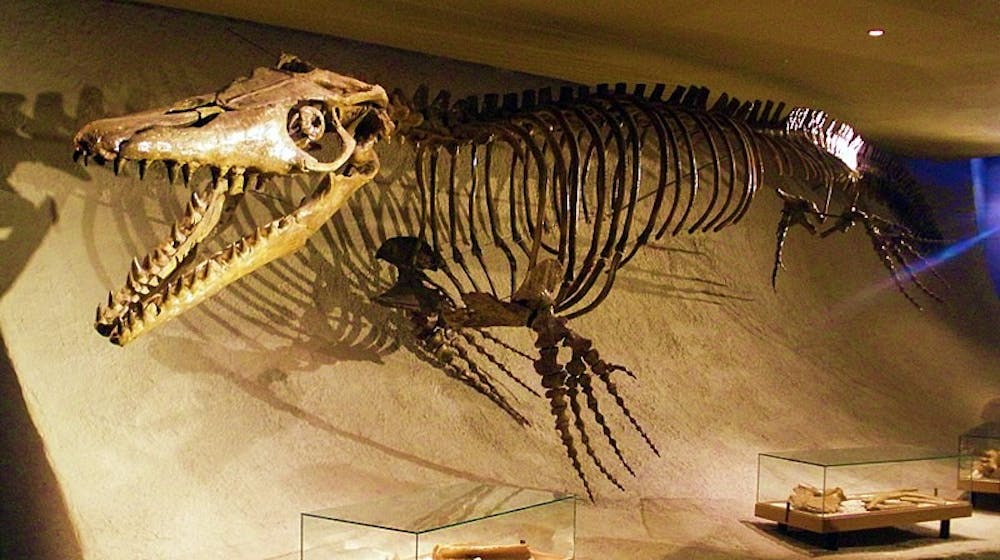Until Jurassic World brought the mosasaur back to life on the big screen, the gigantic sea predator had been extinct for 65 million years, since the Cretaceous period. Mosasaurs were once the apex predators of the sea, and a recent study shows they may have hunted like the modern-day apex predator, the orca whale.
Paleobiologist Takuya Konishi at the University of Cincinnati made the connection while studying a juvenile mosasaur found in Kansas.
When the mosasaur lived, Kansas and the rest of the middle of the U.S. were underwater, forming the Western Interior Seaway. The part of Kansas where the mosasaur was discovered, known as Monument Rocks, is robust in marine fossils.
Paleobiology is the study of ancient organisms through fossils, and often includes trying to understand the behaviors of the animals. This can be hard to do from only bones, but paleobiologists believe that all forms were evolved to have a specific function.
According to the National Center for Biotechnology Information, paleobiologists have three approaches to finding these functions: using empirical evidence, biomechanical modeling and comparing to similar modern-day organisms.
Empirical evidence includes studying the surrounding rocks to analyze climate at the time of death, other nearby fossils to learn about the ecosystem, and trace fossils such as footprints or burrows that can show how the organism moved.
Biomechanical modeling involves inputting the fossils into computer programs, which can then provide a more in-depth analysis of the organism. This could include the center of mass, which would give an idea as to how the organism walked, how fast the organism could run or how thick it’s skull is, indicating mating behaviors such as head butting.
Konishi used an approach similar to comparing the fossil to a modern-day organism. This approach uses modern-day organisms to trace back characteristics to a common ancestor. For example, if three types of birds have the same pattern of feathers, then their common ancestor likely had the same pattern of feathers.
Konishi used the structure of the skeleton of the mosasaur to find a possible modern-day relative. Although first identified as a platecarpus mosasaur, Konishi re-identified it as a tylosaurus mosasaur. Tylosaurus was the largest of the mosasaurs, growing to nearly the size of a school bus. It also had a protrusion on its upper jaw called a rostrum, which is very similar to an orca whale.
“It’s a subtle feature perhaps by horned dinosaur standards, but for us it really signifies what kind of mosasaur you’re looking at,” Konishi said in a press release. “If you have this protruding snout in this part of western Kansas, you’re a Tylosaurus.”
The rostrum in an orca whale is a bone bump that serves to protect its teeth. Orcas often hunt by ramming their six-ton bodies into their prey at speeds of up to 48 kilometers per hour. The rostrum protects the teeth of the orca during these collisions and possibly had the same function in the mosasaur. This leads Konishi to believe that mosasaurs had similar hunting habits to orca whales.
As apex predators, even to great white sharks, orcas eat sea birds, squid, octopuses, sea turtles, sharks, rays and fish. Orcas are also the only animal to purposefully beach itself, driving its body onto the sand to catch seals. Ken Balcomb, a scientist at the Center for Whale Research, has studied orca whales for 43 years.
“They pummel their prey quite a bit. They will throw their body against a gray whale. They’ll ram great white sharks, too,” Balcomb said in a press release.
Previous work has shown that mosasaurs ate mostly fish, but they occasionally also ate seabirds, sharks, plesiosaurs (another large marine reptile) and even other mosasaurs.
Knowing how mosasaurs hunted allows scientists to paint a more complete picture of how the world used to be, giving more fuel to fantasies such as Jurassic World. It also allows scientists to understand how orca whales evolved and the process of evolution itself.
“We now have a bit better insight into how this trademark feature evolved in this lineage,” Konishi said. “It’s a good starting point for more studies in the future.”
Previous work has shown that mosasaurs ate mostly fish, but also seabirds, sharks, plesiosaurs (another large marine reptile), and even other mosasaurs.
Knowing how mosasaurs hunted allows scientists to paint a more complete picture of the how the world used to be, giving more fuel to fantasies such as Jurassic World. It also allows scientists to understand how orca whales evolved, and the process of evolution itself.
"We now have a bit better insight into how this trademark feature evolved in this lineage," Konishi said. "It's a good starting point for more studies in the future."





